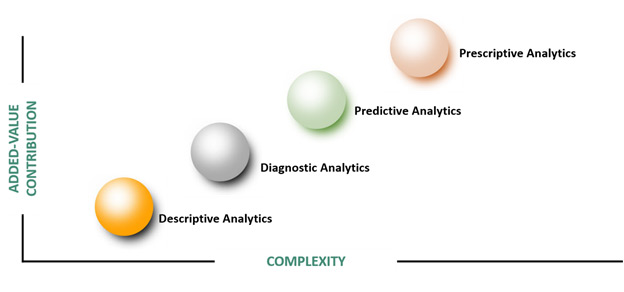Advanced Analytics
Advanced Analytics is the systematic examination of data or content using statistical techniques and tools to gain and comprehend deeper insights and provide recommendations, which are beyond the traditional business intelligence (BI). Advanced analytic techniques include those like sentiment analysis, data/text mining, machine learning, visualization, pattern matching, forecasting, semantic analysis, network and cluster analysis, multivariate statistics, graph analysis, simulation, complex event processing and neural networks.
Many companies are using Big Data to make important sensitive business decisions, by gaining the right information carrying the knowledge that imparts businesses the power to gain a competitive edge. Big Data Analytics help an organization to make smarter decisions for better business outcomes.
What we do?
TechSci Research has expert professionals and the Big Data solutions are
divided into 4 major categories based on the complexity level.

Descriptive Level
It is the most common form of practice, which answers the simplest business
question “What has happened?”.
This type of analytics analyses the data that comes in real time and the
historical data for insights on how to approach the future. The main
objective of the descriptive analytics is to understand the consumers’
needs.
Most of the social analytics are descriptive analytics in nature. The
calculations summarize certain groupings based on some events. The social
media variables such as followers, posts, likes and fans are mere event
counters. The fundamental metrics are used for social analytics such as
average response time, average number of replies per post, etc.
Google Analytics help understand what happened in the past and what can be
validated through the results of promotional campaign’s analysis.
Tools Used – SPSS, SQL
Diagnostic Level
Diagnostic analytics lets you understand your data faster to answer
critical workforce questions. TechSci Research provides the fastest and
simplest way for organizations to gain meaningful insight into their
employees and solve many complex business issues. Interactive data
visualization tools like Tableau allow managers to easily search, filter
and compare data by centralizing information from across the TechSci
Research exhaustive database.
Tools Used – R, Python, Tableau, SAS
Predictive Level
The third level is predictive analytics. Analysis of past data trends and
patterns can 100% accurately answer the question of “What happened in the
past?”. This helps in setting realistic goals for the business which
further leads to effective planning and keeping expectations. Predictive
analytics is used to study the primary data and to find answers to the
complex questions. Also, the tool lets the client to put the points forward
of “What can happen in the future based on previous trends & results?”.
TechSci Research has been forecasting business trends from the past eight
years and pioneered to figure minute consumer details.
Predictive analytics helps to predict the likelihood of a future outcome by
using various statistical and machine learning algorithms. It is based on
many probabilities, thus not always 100% accurate. To make predictions,
algorithms consider data and fill in the missing data with best possible
guesses.
TechSci Research works on the below Predictive analytics categorization
- What will happen next?
- The Root Cause Analysis-Why happened?
- Further Data Mining- Identifying correlated data.
- Forecasting- Future Trends?
- Monte-Carlo Simulation – What can happen?
- Pattern Identification–When should be the action to correct a process?
- Tools Used – R, Python, SQL
Prescriptive Level
Big data highlights the problems and help a business to understand why
those problems occurred. Businesses can use the data-backed and data-found
factors to show a directional solutional for the business problems, that
further lead to realizations and observations.
Prescriptive analytics suggest possible outcomes and result in actions that
are likely to maximize the key business metrics. It basically uses
simulation and optimization to enquire, “What should a business do?”.
Why Should Every Organization Use Advanced Analytics?
Organizations have more data than ever at their disposal with the growth of online platforms and dynamic business environments. But deriving meaningful insights from the data is crucial to make strategic and operational decisions. Here’s how organizations are leveraging advanced analytics to their advantage.
Choosing the Right Data
As the sheer volume of data is continuously growing, particularly from new sources such as social media and artificial intelligence solutions, advanced analytics provides more panoramic and more granular views of their business environment. Advanced analytics is a powerful and less costly solution for improving operations, enhancing customer experiences, and building strategies.
Sourcing Data Creatively
Often companies have all the required data to tackle business problems, but they do not know how to use that information to make key decisions. For instance, a banking team needed to improve the efficiency of its customer operations, so they compiled information from different sources like online queries, complaints, ATM transactions that allowed identification of duplicate interaction, which ultimately led to reduced costs and streamlined customer experience.
Customer Acquisition and Retention
To stand out from the competitors, organizations must follow a unique approach to market their products. Utilizing advanced analytics, companies can pinpoint what exactly customers are looking for and establish a solid customer base. Big data processes help observe patterns, which can be further used to identify trends and enhance customer satisfaction. Monitoring online purchases and observing point-of-sale transactions can allow companies to create targeted campaigns.
Identification of Potential Risks
Advanced analytics has been instrumental in developing risk management solutions, which are vital for high-risk environments. Predictive risk management is crucial to prevent the loss, minimize risk loss, and enhance awareness of the external threats to the company.
Build Innovative Products
Advanced analytics help companies improve existing products and innovate new ones, taking into consideration the large amount of data. Additionally, an organization can implement processes to track its customer’s feedback and determine its competitor’s success metrics.
TechSci Research uses the tool to

- Optimize all possible outcomes that help achieve the business objective.
- To Stochastically optimize the outcome that helps understand how to
achieve the best outcome.
- To identify the data uncertainties to make better decisions.
Tools - All Machine Learning tools